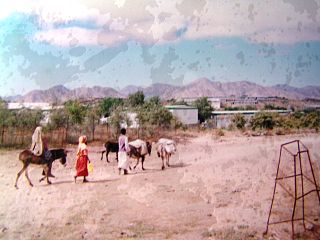Overview
Dahlak Subregion consists of two large and 124 small islands. Only four of the islands are permanently inhabited, of which Dahlak Kebir is the largest and most populated. The islands are a home for diverse marine life and sea-birds, and attract some tourists.
The archipelago's inhabitants speak Dahlik. Some of the islands can be reached by boat from Massawa.
Other inhabited islands of the district, besides Dahlak Kebir are: Dhuladhiya, Dissei, Dehil (Dohul), Erwa, Harat, Hermil, Isra-Tu, Nahaleg (Nahleg), Nora (Norah) and Shumma, although only Dissei, Dehil and Nora are permanently inhabited.

The Arctic Archipelago, also known as the Canadian Arctic Archipelago, is an archipelago lying to the north of the Canadian continental mainland, excluding Greenland and Iceland.

The Dahlak Archipelago is an Eritrean island group located in the Red Sea, measuring around 643 square km and lying roughly 58 kilometers east of Massawa, the regional capital city.

Nakfa, Tigrinya: ናቕፋ, is a town in the Northern Red Sea region of Eritrea. It is also the name of a sub region of Eritrea.

Dahlak Kebir is the largest island of the Dahlak Archipelago. Situated in the Red Sea off of the coast of Eritrea, it was formerly called Dahlak Deset.

The Buri Peninsula extends from central Eritrea north into the Red Sea.

The Northern Red Sea region, is an administrative region of Eritrea. It lies along the northern three quarters of the Red Sea, and includes the Dahlak Archipelago and the coastal city of Massawa.

Dahalik is an endangered Afroasiatic language spoken exclusively in the Dahlak Archipelago in Eritrea. Its speech area is off the coast of Massawa, on three islands in the Dahlak Archipelago: Dahlak Kebir, Nora, and Dehil.

The Hanish Islands conflict was a dispute between Yemen and Eritrea over the island of Greater Hanish in the Red Sea, one of the largest in the then disputed Zukur-Hanish archipelago. Fighting took place over three days from 15 December to 17 December 1995. In 1998 the Permanent Court of Arbitration determined that the territory belonged to Yemen.

Soemmerring's gazelle, also known as the Abyssinian mohr, is a gazelle species native to the Horn of Africa. The species was first described and given its scientific name by German physician Philipp Jakob Cretzschmar in 1828. Three subspecies are recognized. It is possibly no longer present in Sudan.
The Tigre people are an ethnic group indigenous to Eritrea. They mainly inhabit the lowlands and northern highlands of Eritrea, with a small population in Sudan.
Articles related to Eritrea include:
Dahlak (Dahlac) Marine National Park is a national park in the Northern Red Sea Region of Eritrea. It includes part of the Dahlak archipelago and the surrounding waters.
Paşalimanı Island, formerly Halone, is an island in the southern Sea of Marmara in Turkey. The island is the fifth largest island of Turkey and administratively belongs to the Erdek town of Balikesir Province in northwestern Turkey. The island has five small villages and has 962 population in total. Paşalimanı Island is also part of the Marmara Archipelago along with three other islands Marmara, Avşa and Ekinlik.

Nora is the second largest island in the Dahlak Archipelago, Eritrea, and one of the three inhabited islands of the archipelago. It has an area of 105.15 km2. It reaches a maximum height of 37 meters in the northeast.

Harmil is an uninhabited island in Eritrea that forms part of the Dahlak Archipelago. The inhabitants are serving members of the Eritrean Navy who have a small outpost on the island. The outpost consists of a small pier in the southwest bay and a camp about 1 km north-northwest from the pier that may be unoccupied.
Nakura or Nokra is an Eritrean island in the Dahlak Archipelago situated west of Dahlak Kebir. Nakura has an area of 6.44 km2, and reaches a height of 48 meters.
Bāḍiʿ was a medieval African port on the Red Sea. It was the first port established by the Arabs in the Bilād al-Sūdān and flourished between about 600 and 1100. It was a merchant settlement conducting trade between its hinterland and Arabia. It does not appear to have fallen under the authority of any established state.

The Djibouti xeric shrublands is an ecoregion defined by One Earth, consisting of a semi-desert strip on or near the Red Sea and the Gulf of Aden coasts in Eritrea, Ethiopia, Djibouti and Somalia. This ecoregion lies mainly between sea level and 800 meters (m) elevation. There are, however, many hills and massifs, which range up to 1300 m as well as outstanding fault-induced depressions, such as the Danakil, lying as low as 155 m below sea level. This region is extremely active tectonically, experiencing many earthquakes and intermittently active volcanoes. Rainfall is very low and yearly averages range from 100 to 200 millimeters (mm), with less rain falling closer to the coast. There are many species of interest, including the endemic Archer's lark, a species of dragon tree, and a large suite of desert ungulates, including the last viable population of African wild ass.

The Sultanate of Dahlak was a small medieval kingdom covering the Dahlak Archipelago and parts of the Eritrean coast. First attested in 1093, it quickly profited from its strategic trading location, gaining heavily from being near to Yemen as well as Egypt and India. After the mid 13th century Dahlak lost its trade monopoly and subsequently started to decline. Both the Ethiopian empire and Yemen tried to enforce their authority over the sultanate. It was eventually annexed by the Ottomans in 1557, who made it part of the Habesh Eyalet.
This page is based on this
Wikipedia article Text is available under the
CC BY-SA 4.0 license; additional terms may apply.
Images, videos and audio are available under their respective licenses.














